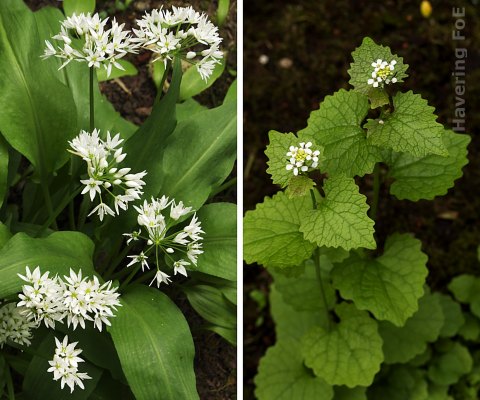Foraging for wild food
by John Robinson; first published 5-May-2023

Ramsons and Garlic Mustard - John Robinson
Before farming was invented, our distant ancestors are said to have been hunter-gatherers. Hunting may be frowned upon nowadays, but a modest bit of gathering is still a great way to appreciate the value of the countryside!
At this time of year, many leaves and even some flowers are delightful in a sandwich, salad, or just munched straight from the plants. Pictured are two of my favourites: Wild Garlic (aka Ramsons) and Jack-by-the-hedge (aka Garlic Mustard). In both cases the whiff of garlic from a crushed leaf will confirm that you have the right plant. Bittercress is a useful little plant that thrives as a "weed" in my damp clay garden, and has a peppery taste like rocket. Even the humble dandelion can be eaten, and apparently a coffee substitute can be made from its roots.
Some banks along the Thames estuary are covered with a plant called Alexanders, whose stems can be cooked like celery. Goosegrass can also be cooked, and young stinging nettles make a legendary soup. In June, look out for elderflowers. They're delicious eaten straight from the tree, and if you're really adventurous you can turn them into a lovely white wine. Just remember that every flower picked means fewer berries for red wine later in the year!
Wild fruits come into their own in Autumn, and not just blackberries. The true crab apple is inedible raw, but there are lots of hybridised apple trees out there, which produce sweeter fruit. Plum-alikes come in various sizes. The larger ones (damsons) can be delicious, and the marble-sized sloes, while too mouth-puckeringly sharp to eat, make a Sloe Gin which I much prefer to the commercial sort.
The location of sweet chestnuts is often a locally-guarded secret, but if you find some there's no better way to end a late autumn walk than by roasting them in a hot oven. Always slit the skins first, to avoid them exploding!
A few plants might make you ill while others are dangerously toxic, so you need to identify your wild food carefully. There's plenty of information on the internet, and I strongly recommend the book Food for Free by Richard Mabey; a handy pocket-size version is available.
![[Earth icon]](../emblem64.jpg)